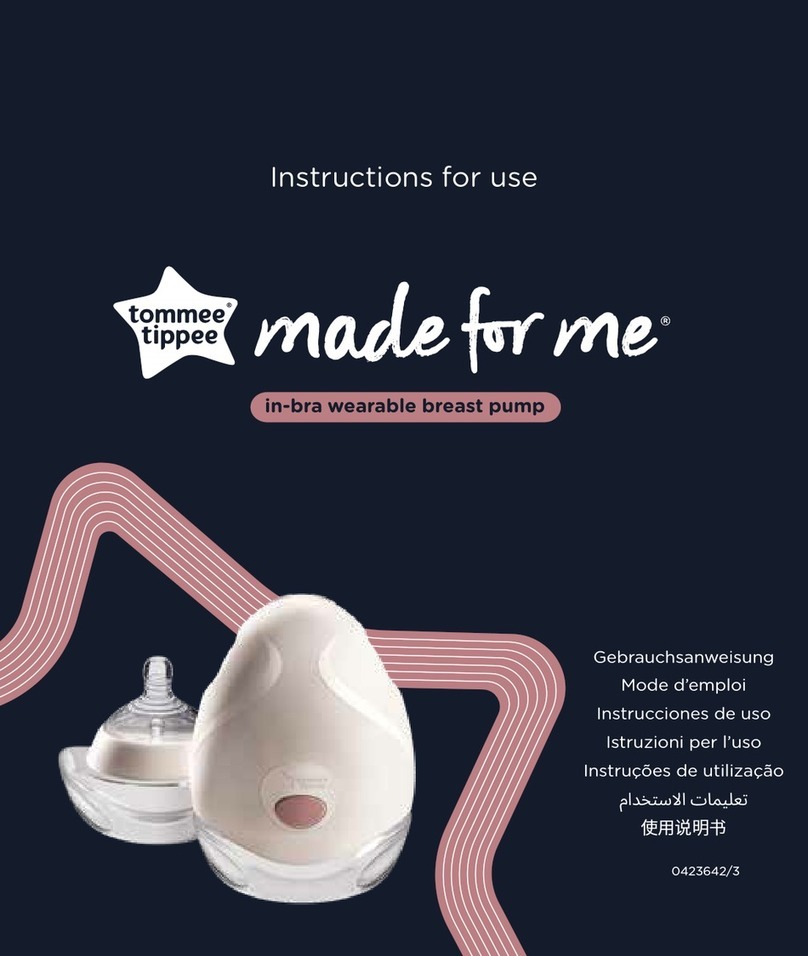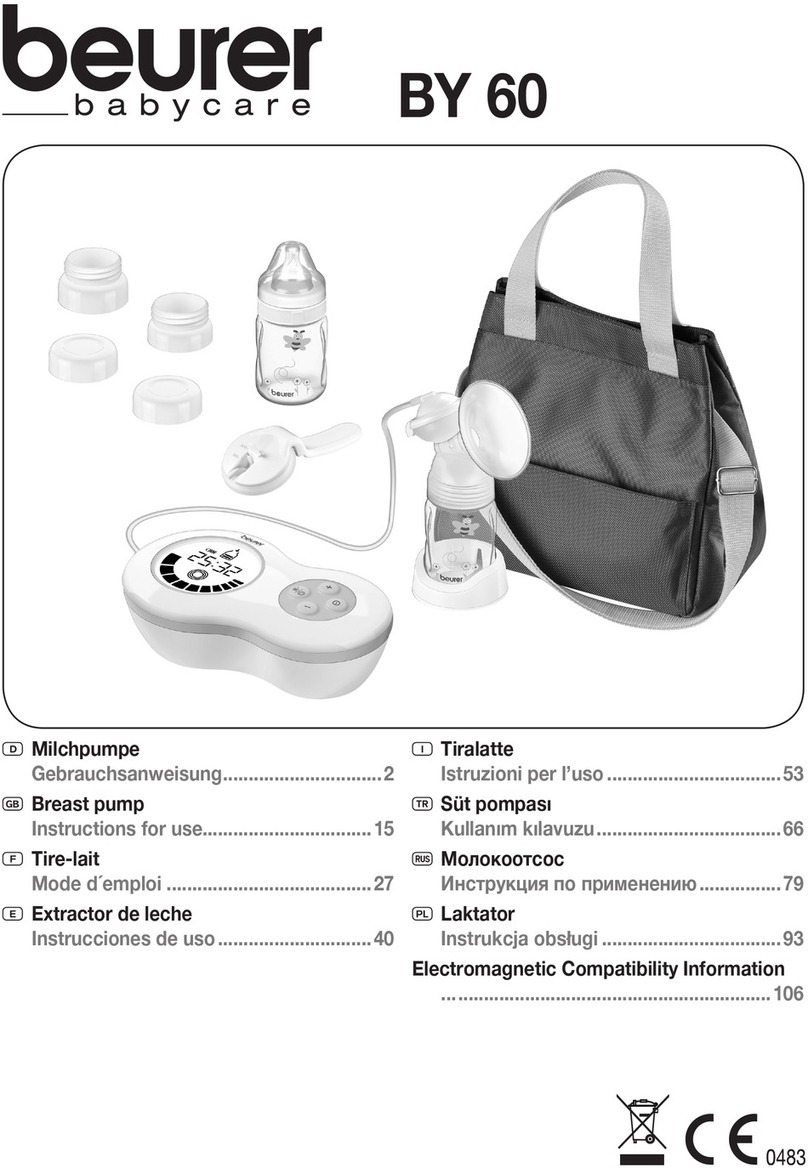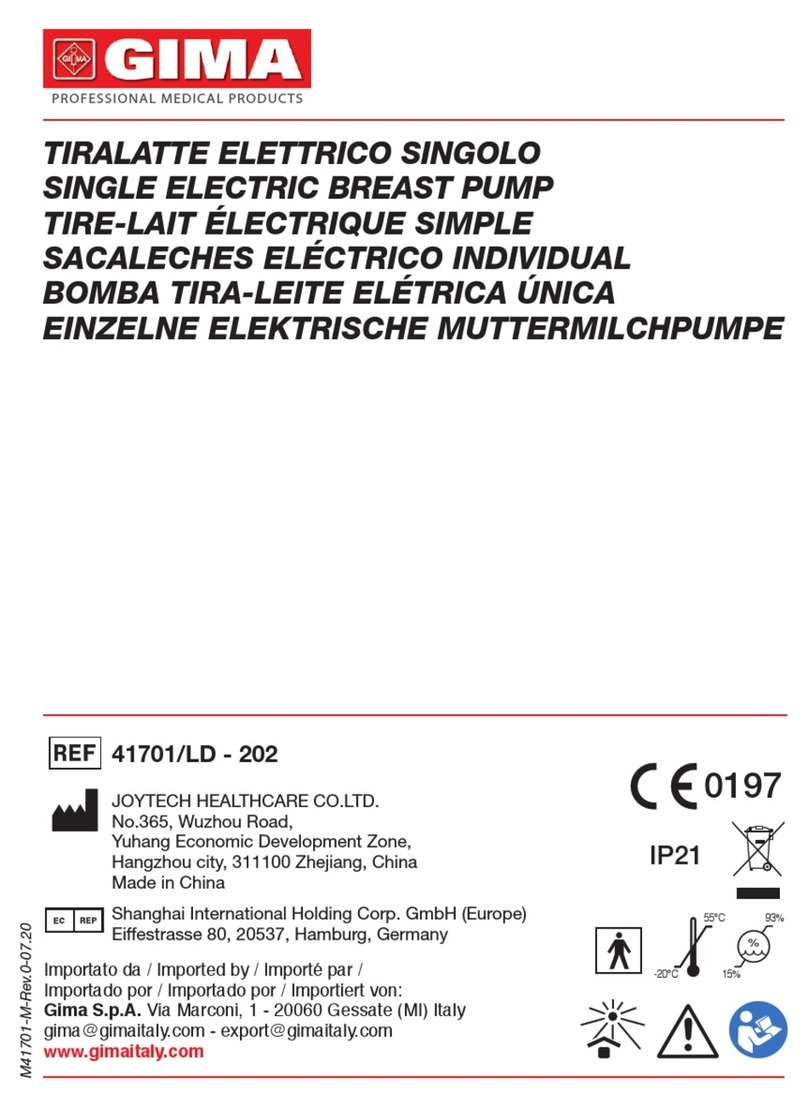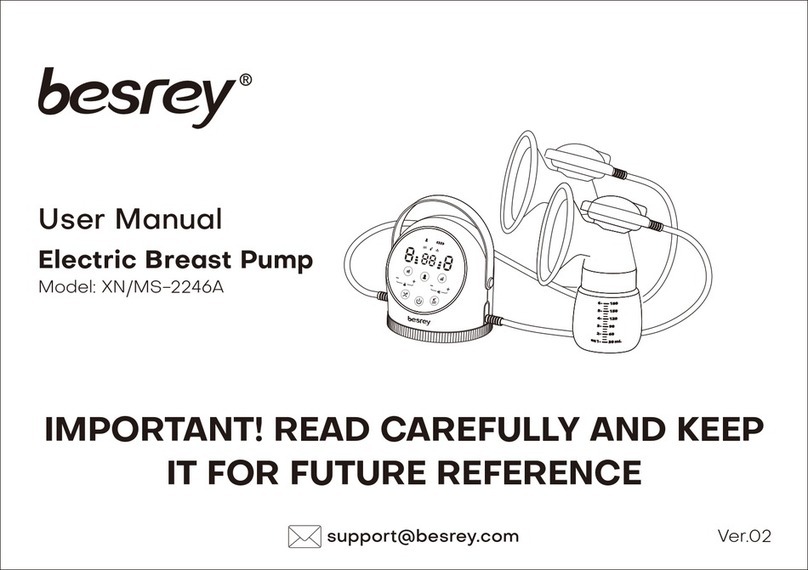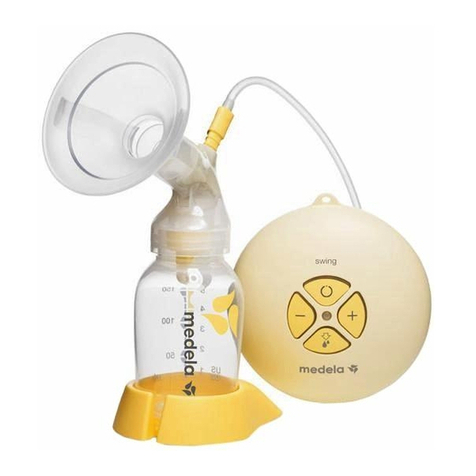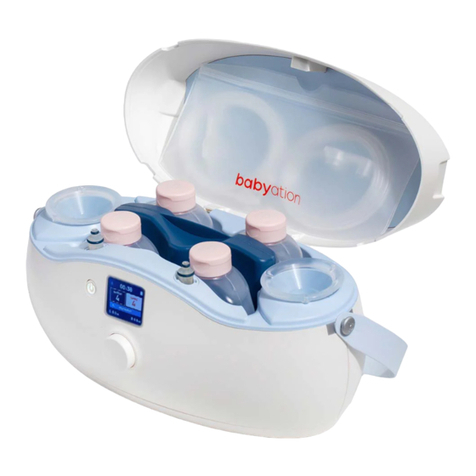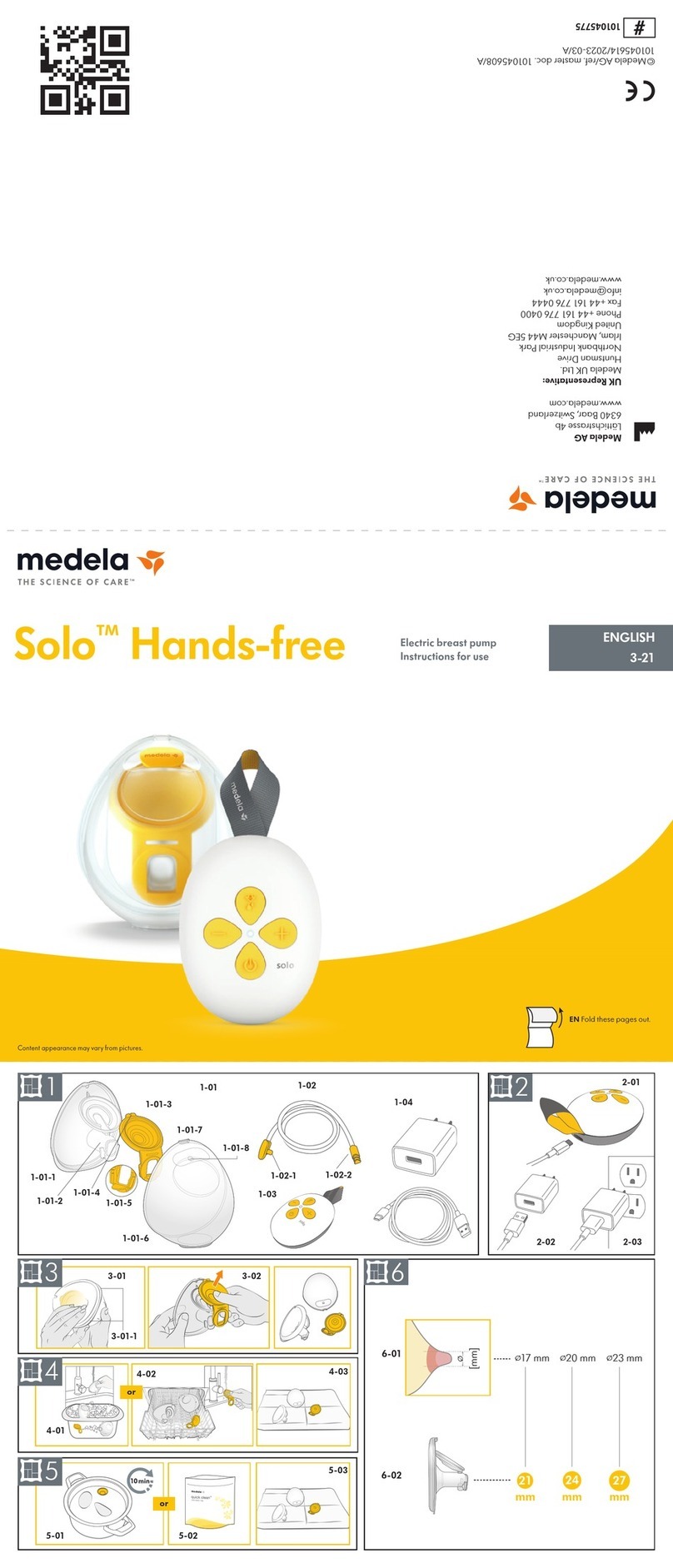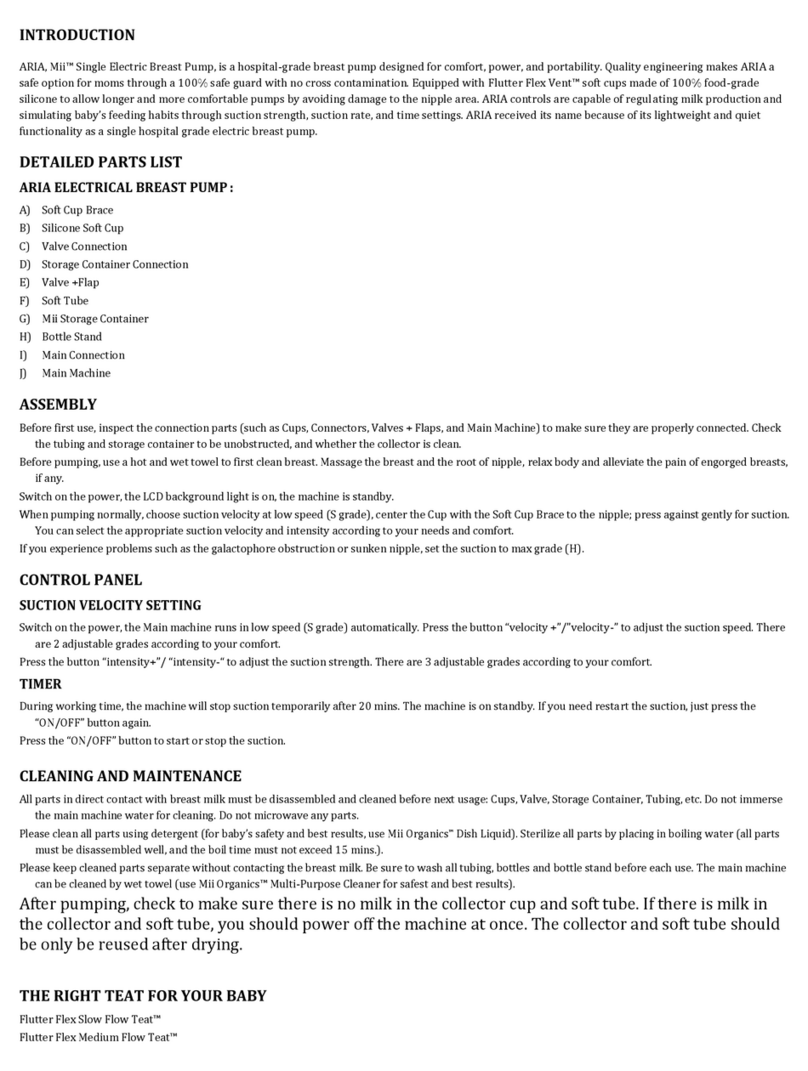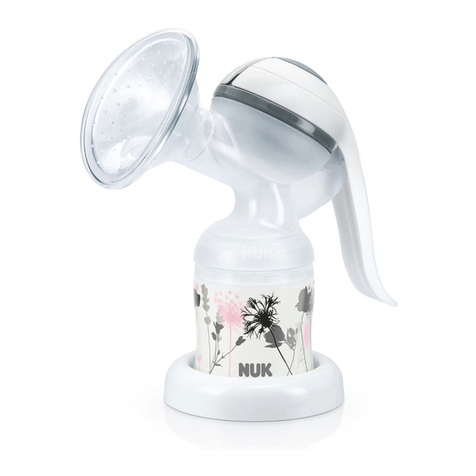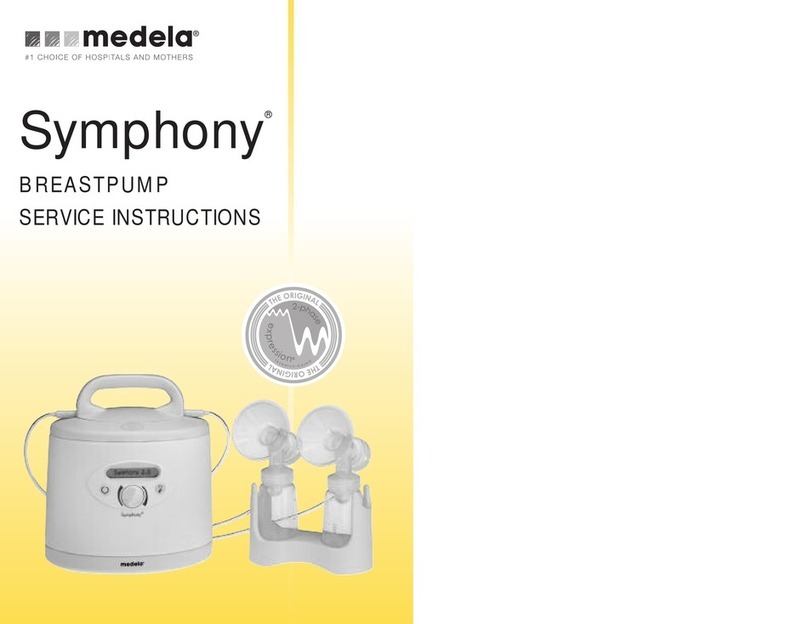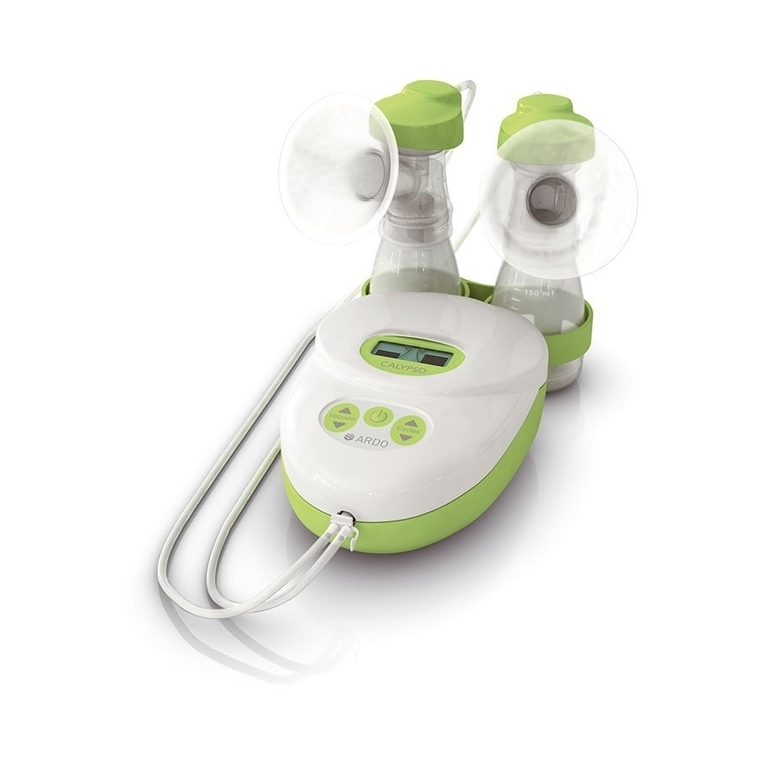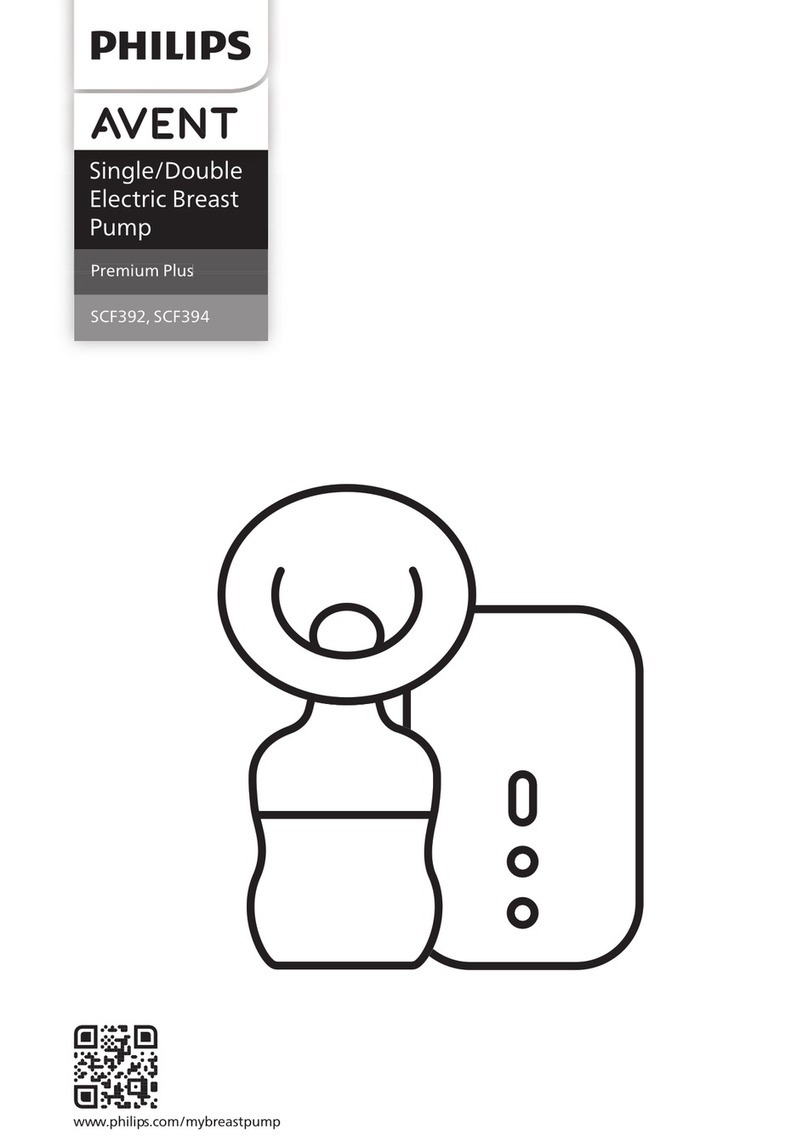Manamed Nature's Bond NB603 User manual

www.manamed.com
888.508.0712
Breast Pump Instructions For Use
Model NB603
IFUNB603 Rev A 10132020

1
Symbol List
Warning/Caution: See instructions for use
Type BF Applied Part
Keep Dry
Serial Number
Manufacture Lot Number
SN
LOT
Class II Equipment
Authorized Representative in the European Community
Use By
Date Of Manufacture
Waste Electrical Goods Recycled
Manufacturer
Catalog / Model Number
Protected against solid foreign objects of 12.5mm and
greater and vertically falling water drops.
IP21
ATTENTION: Consult ACCOMPANYING DOCUMENTS. This symbol is used
to direct the user to refer to documentation for additional
information regarding the system use or description.
Dangerous Voltage
Electrical shock hazard. Disconnect LINE CORD before
servicing; refer servicing to qualified service personnel.

2
Specification
Dimensions For Main Unit: 185mm X 126mm X 57mm
Flow Rate; No Filter;
Under Maximum Pressure: ≥7 L/min
Highest Negative Pressure
At Stimulation Stage: ≤200mmHg
Highest Negative Pressure
At Expression Stage: ≤300mmHg
Operating Cycle
At Stimulation Stage: Approx.120 times/min
Operating Cycle
At Expression Stage: Approx. 60 times/min
AC Input Voltage Range: 100-240VAC
Operating Frequency: 47-63HZ
Input Current: 600mA, Max
Output Current: 2A, Max
Output Power: 18W
DC Output Voltage Range: 12V±5%
Weight Of Main Unit: Approx. 400g
Battery Specifications: 6 x 1.5 Vdc AA LR6 Battery
Environmental Conditions: ≤60dB(A)
Operating Atmospheric Pressure: 700hPa-1060hPa
Storage Conditions: Temperature: -25°C-70°C
Humidity: 0-93%
Operating Conditions: Temperature: 5°C-40°C
Humidty: 15%-93%

3
Warnings
Basic safety precautions should be taken when using electrical products, especially
around children.
DANGER: To reduce risk of electrocution:
• The power adaptor is a part of the breast pump.
• Always unplug electrical products immediately after use.
• Do not use while bathing.
• Do not place or store product where it can be submerged in water.
• Do not reach for device once it has fallen in water. Immediately unplug from
electrical outlet.
• Do not leave device unattended when plugged into an electrical outlet.
• Do not position the breast pump such that it is difficult to disconnect the adaptor plug
from the main power supply.
• Remove batteries when Breast Pump is not likely to be used for some time because
battery leakage could become a hazard.
• Close supervision is necessary when used near children or people with disabilities.
• Use product only for its intended use. Do not use attachments not recommended by the
manufacturer.
• Keep cord away from heated surface.
• Never use while sleepy or drowsy.
• Never drop or insert objects into any opening or tubing.
• Do not use outdoors or operate where aerosol products are being used, or where
oxygen is being administered.
• Always inspect power adaptor and batteries prior for use for damage and exposed
wires. If damage is found, immediately discontinue use of power adaptor or
batteries and contact ManaMed’s Customer Service.
• Do not use outdoors or operate during transportation.
WARNING: To avoid health risk and reduce the risk of injury:
• This product is intended for single user only and should not be shared between users.
• Do not drive while pumping.
• Never use while pregnant, as pumping can induce labor.
• Clean and sanitize all parts that come in contact with your breast and breast milk prior
to first use.

4
Warnings (continued)
WARNING: To avoid health risk and reduce the risk of injury:
• Wash all parts that come in contact with your breast and breast milk after every
use.
• Inspect all appropriate pump components before each use.
• Do NOT continue pumping for more than 2 consecutive pumping sessions if no
results are achieved.
• Do not thaw frozen breast milk in a microwave or in a pan of boiling water.
• If tubing becomes moldy, discontinue use and replace tubing.
• If breast milk backup occurs, you must clean the tubing before your next pumping
session.
WARNING: Can lead to minor injury:
• Do NOT wrap cord around adaptor body.
• Use only the power adaptor that comes with the Nature’s Bond breast pump.
• Pump only with the breast pump in an upright position.
• Do NOT shorten tubing.
• Make sure the voltage of the power adaptor is compatible with the power source.
• Plug the power adaptor into the breast pump first, then into the power source.
• Do NOT use antibacterial or abrasive cleaners/detergents when cleaning breast
pump or breast pump parts.
• Never put breast pump motor in water or sterilizer, as permanent damage can be
caused to the device.
• Do not attempt to remove the breast shield from your breast while pumping. Turn
the breast pump off and break the seal between your breast and breast shield with
your finger, then remove the breast shield from your breast.
• If pumping is uncomfortable or causing pain, turn the unit off, break the seal
between the breast and the breast shield with your finger and remove breast shield
from your breast.
IMPORTANT:
• Plastic bottles and component parts become brittle when frozen and may break
when dropped
• Bottles and component parts may become damaged if mishandled (dropped, over
tightened, or knocked over)
• Take appropriate care in handling bottles and components
• Do not use the breast milk if bottles or components become damaged

5
Power Port
Set Button
Mode Button Tubing Connector
Accessories
• 4 Caps
• 2 Breast Shields
• 4 Valves
• Tubing
• Carrying Bag
• 4 Bottles
Power Button
Intended Use
Nature’s Bond breast pump is intended for lactating women to express and collect milk
from their breasts to complement breast feeding.
Description
Nature’s Bond is a personal use electric breast pump that has two pumping modes and
is capable of single and double pumping. Nature’s Bond is to be used when the baby
would normally be breast feeding, which is usually 2 - 3 times a day.

6
Cleaning
Before using for the first time:
• Clean and sanitize the following parts before using your pump for the first time.
Use drinking quality tap or bottled water for cleaning. Take apart and wash all parts
that come in contact with the breast and breast milk immediately after use to avoid
dry up of milk residues and to prevent growth of bacteria. Follow the cleaning and
sanitizing instructions on the below list:
• Breast shield
• Breast shield connector
• Valve
• Breast milk bottles and lids
After each use:
Clean all parts that come in contact with your breast and breast milk.
1. Separate breast shields from breast shield connectors.
2. Twist and pull the valves off the breast shield connectors.
3. Rinse in cool water all separated parts that come in contact with breast and breast
milk in order to remove breast milk residue.
4. Soak all separated parts in warm soapy water for 5 minutes.
5. Clean with a clean dish cloth or soft brush.
6. Rinse all separated parts with clear water.
7. Allow all parts to air dry in a clean area.
8. Store dry parts when not in use.
When using dishwasher:
1. Wash all separated parts on top rack of dishwasher.
2. Allow all breast pump parts to air dry in a clean area.
3. Store dry parts when not in use.
Sanitize daily:
1. Wash hands thoroughly.
2. Separate all parts that come in contact with your breast and breast milk.
3. Fill a pot with enough water to cover all parts.
4. Bring water to a boil.
5. Place parts in boiling water for 10 minutes.
6. Allow water to cool and gently remove parts from water with tongs.
7. Place parts on a clean surface.
8. Allow all parts to air dry.
9. Store dry parts when not in use. Do not store wet or damp parts.
Device and Tubing Cleaning:
1. Turn off breast pump.
2. Unplug breast pump from power source.
3. Remove tubing from the unit.
4. Remove tubing from the breast shield.
5. Rinse tubing in cool water.
6. Wash tubing in warm soapy water.
7. Rinse tubing with clear water.
8. Hang to air dry.
9. Wipe down the unit with a damp soft cloth.
10. To clean the bag, use a damp cloth to wipe the bag down after each use.

7
Assembly of Pump Kit
1. Wash hands before touching breast pump, kit and breasts, and avoid touching the
inside of containers or lids.
2. Place the breast pump on a clean dry surface.
3. Securely attach breast shield to breast shield connector.
4. Push valves onto bottom of breast shield connectors.
5. Screw bottles onto breast shield connectors.
6. Insert tubing into the back of the breast shield connectors.
7. For double pumping, insert the free ends of the tubing onto both ports of the tubing
connector on the device.
8. For Single Pumping, insert free end of tubing onto one port on the tubing
connector on the device. Place the port cap over the unused port.
9. Correctly install 6 AA batteries into the battery enclosure located on the back of the
device.
10. To use AC power, plug the power adaptor into the power jack on the device. Plug the
power adaptor into a safe, proper electrical outlet.
Correctly fitting breast shields:
1. Properly fitting breast shields will ensure comfort and efficient milk expression. While
some discomfort may be felt when first using a breast pump, it should not cause pain.
Please contact a healthcare professional if you are unsure about breast shield sizing.
2. The nipple should be centered in the tunnel of the shield.
3. The nipple should move freely without rubbing when the pump is turned on.
4. Minimal or no part of the areola should be pulled into the tunnel when the pump is on.
5. You should see a gentle, rythmic motion with the breast during each cycle.
6. After pumping, your breast should feel much less full with no areas of hardness.
Device Operation
• Wash hands before touching breast pump, kit and breasts. Avoid touching the inside of
containers or lids.
• Always inspect breast shields, connectors, valves, and tubing prior to use for
cleanliness.
• If you experience pain or other symptoms while pumping, contact a healthcare profes -
sional.
• Do not try to express with a vacuum that is too high and uncomfortable.
• Make sure tubing is not kinked or pinched while pumping.
• Contact your healthcare professional if you express on minimal milk or no milk or if
expression is painful.
1. Center the assembled breast shields over your nipples.
2. To begin pumping, press the “Power” button. When the device is powered on, a
green LED will illuminate.
3. The Nature’s Bond has two pumping modes, Stimulation and Expression. A green
LED will illuminate during Stimulation Mode, a blue LED will illuminate during
Expression Mode.
4. The two phases can be switched by pressing the “Mode” button. The pump will start
in Stimulation Mode and beep after 2 minutes when it is time to switch to Expression
Mode.
5. Vacuum strength can be adjusted by pressing the “Up” and “Down” buttons. Adjust
accordingly to your comfort.
6. When the pumping session is over, unplug the tubing from the breast shields before
setting down the bottles.
7. Close the bottle with a lid. Store appropriately.
8. Allow the pump to continue to run while you store the breast milk. This will allow any
condensation that has formed to dry in the tubing.
9. Turn off breast pump.
10. Unplug from the power source.
11. Prior to storing your pump, remove the tubing.
12. Disassemble and clean per the Cleaning Instructions.
13. A yellow LED illuminating during treatment indicates “Low Battery.” Change the
batteries when the LED turns yellow.

8
Breast Milk Storage Guidelines
Room Temp Cooler with Ice Pack Refrigerator Freezer Thawed Breast Milk
4–6 hours
at 66–78 °F
(19–26 °C)
24 hours
at 59 °F
(15 °C)
3–8 days
at 39 °F
or lower
(4 °C)
6–12
months
0 – -4 °F
(-18 – -20 °C)
use within 24 hrs
Storing Breast Milk
References: www.BreastmilkGuidelines.com
Preparing Breast Milk
• Thaw breast milk overnight in the refrigerator. Thawed breast milk is safe in the
refrigerator for 24 hours. Do not refreeze thawed breast milk.
• Quickly thaw breast milk by holding the bottle under warm running water.
• Place the sealed bottle in a bowl of warm water for 20 minutes to bring it to body
temperature.
• If you are adding expressed breast milk to a container of already frozen breast milk,
make sure to add a lesser amount than the already frozen amount.
Feeding Breast Milk
It is recommended that breastfeeding is well established prior to bottle feeding your baby.
• Always inspect the bottle, nipple and other components immediately before and
after each use. If nipple appears cracked or torn, discontinue use immediately.
• To prevent possible choking hazard, test strength of nipple by pulling on bulb
portion of the nipple.
• Do not attempt to enlarge the nipple hole.
• Infants must not be bottle fed without adult supervision.
• Nipple should not be used as a pacifier.

9
Disposal
Medical equipment and devices should be disposed of in proper containers that meet
Environmental Protection Agency standards. Check with local State Laws &
Regulations to see what is required in your state or contact your local
representatives.
Maintenance and Replacement Parts:
The Nature’s Bond device contains no user serviceable parts inside: Opening or
tampering with this device will void the warranty. In the event the Nature’s Bond
device requires repairs, it should be returned to the medical equipment
company or to Manamed directly. Expected lifetime of the device is
two years under normal use.
Warranty Information
ManaMed warrants its Nature’s Bond Breast Pump, excluding accessories
(“Breast Pump”) to be free from defects in workmanship and materials for a period
of one (1) year from the date Device is delivered to the original purchaser (“Breast
Pump Warranty Period”). In addition, ManaMed warrants its Breast
Pump Accessories, (defined as bottles, caps, tubing sets, carrying case and breast
shields) (“Accessories”), to be free from defects in workmanship and materials for a
period of ninety (90) days from the date the Accessories are delivered to the original
purchaser (“Accessories Warranty Period”). This Limited Warranty is extended only
to the original purchaser (defined as the original purchaser from the distributor) and
is non-transferable. ManaMeds’ sole obligation under this Limited
Warranty shall be, at its sole discretion, to repair or replace a Device which is
defective in either workmanship or material. This is the sole remedy of the
Purchaser. In addition, this Limited Warranty does not cover any Device which may
have been damaged in transit or has been subject to misuse, neglect, or accident; or
has been used in violation of ManaMeds’ instructions, including,
without limitation, the instructions contained in the Operation Manual.
Troubleshooting
Low or no suction:
• Check valve and tubing for chips or cracks. If flawed, replace valve or tubing
respectively.
• Inspect breast shield and breast shield connector to make sure there are no cracks
and they are securely attached to each other.
• Check all connections to ensure that they are tight and secure.
Will not power on:
• Check to make sure the outlet is proper and functioning.

10
Manufactured For
ManaMed
5240 W Charleston Blvd.
Las Vegas, NV 89146
Ph: 888-508-0712
www.ManaMed.com
Warranty Information (continued)
THERE ARE NO WARRANTIES THAN THOSE EXPRESSLY STATED HEREIN.
TO THE EXTENT PERMITTED BY LAW, MANAMED DOES NOT
MAKE ANY IMPLIED WARRANTY OF MERCHANTABILITY OR FITNESS FOR A
PARTICULAR PURPOSE AS TO ANY PRODUCT OR DEVICE, WHETHER OR NOT THAT
PRODUCT OR DEVICE IS COVERED BY ANY EXPRESS WARRANTY CONTAINED
HEREIN.
IN NO EVENT SHALL MANAMED BE LIABLE FOR ANY SPECIAL,
INCIDENTAL, CONSEQUENTIAL, OR INDIRECT DAMAGES (INCLUDING, WITHOUT
LIMITATION, DAMAGES FOR LOSS OF PROFITS, USE OR TIME INCURRED BY
PURCHASER OR END USER). IN ADDITION, MANAMED SHALL
NOT BE LIABLE FOR ANY EXEMPLARY OR PUNITIVE DAMAGES.
Appendix 1
Important information regarding Electro Magnetic Compatibility (EMC)
With the increased number of electronic devices such as PC’s and mobile (cellular)
telephones, medical devices in use may be susceptible to electromagnetic
interference from other devices. Electromagnetic interference may result in incorrect
operation of the medical device and create a potentially unsafe situation. Medical
devices should also not interfere with other devices.
In order to regulate the requirements for EMC (Electro Magnetic Compatibility) with
the aim to prevent unsafe product situations, the EN 60601-1-2: 2001+A1:2006
standard has been implemented. This standard defines the levels of immunity to
electromagnetic interferences as well as maximum levels of electromagnetic
emissions for medical devices

11
Appendix 2
A. Instructions for use
1. MODEL NB603 needs special precautions regarding EMC and needs to be installed and put
into service according to the EMC information provided in the ACCOMPANYING
DOCUMENTS;
2. Portable and mobile RF communications equipment can affect MODEL NB603.
B. Technical description
1. Warning: the use of accessories, transducers and cables other than those specified with
the exception of transducers and cables sold by the manufacturer of the MODEL NB603 as
replacement parts for internal components, may result in increased EMISSIONS or
decreased IMMUNITY of the MODEL NB603 .
2. Warning: the MODEL NB603 should not be used adjacent to or stacked with other
equipment
3. Guidance and Manufacturer’s Declaration - Electromagnetic Emissions
The MODEL NB603 is intended for use in the electromagnetic environment specified
below. The customer or the user of the MODEL NB603 should assure that it is used in
such an environment
Emissions Compliance Electromagnetic Environment
Guidance
RF emissions
CISPR 11
RF emissions
CISPR 11
Harmonic emissions
IEC 61000-3-2
Voltage fluctuations/
flicker emissions
IEC 61000-3-3
Group 1
Class B
Not applicable
Not applicable
The MODEL NB603 uses RF energy only for
its internal function. Therefore, its RF
emissions are very low and are not likely
to cause any interference in nearby
electronic equipment.
The MODEL NB603 is suitable for use in all
establishments, including domestic
establishments and those directly con-
nected to the public low-voltage power
supply network that supplies buildings
used for domestic purposes.

12
Guidance and Manufacturer’s Declaration - Electromagnetic Immunity
The MODEL NB603 is intended for use in the electromagnetic environment specified
below. The customer or the user of the MODEL NB603 should assure that it is used in
such an environment.
Immunity Test IEC 60601 Test Level Compliance Level Electromagnetic Environment
Guidance
Electrostatic
discharge (ESD)
IEC 61000-4-2
Electrical fast
transient/burst
IEC 61000-4-4
Surge
IEC 61000-4-5
Voltage dips,
short
interruptions
and voltage
variations
on power
supply
input lines
IEC 61000-4-11
Power
frequency
(50/60 Hz)
magnetic field
IEC 61000-4-8
±6 kV contact
±8 kV air
±2 kV for power
supply lines and
dc lines
±1 kV line(s) and
neutral
± 2 kV line(s) to
earth
<5 % UT
(>95 % dip in UT)
for 0,5 cycle
40 % UT
(60 % dip in UT)
for 5 cycles
70 % UT
(30 % dip in UT)
for 25 cycles
<5 % UT
(>95 % dip in UT)
for 5s
3 A/m
±6 kV contact
±8 kV air
±2 kV for power
supply lines and
dc lines
±1 kV line(s) and
neutral
± 2 kV line(s) to
earth
<5 % UT
(>95 % dip in UT)
for 0,5 cycle
40 % UT
(60 % dip in UT)
for 5 cycles
70 % UT
(30 % dip in UT)
for 25 cycles
<5 % UT
(>95 % dip in UT)
for 5s
3A/m
Floors should be wood,
concrete or ceramic tile. If
floors are covered with
synthetic material, the
relative humidity should be
at least 30 %.
Mains power quality should
be that of a typical
commercial or hospital
environment.
Mains power quality
should be that of a typical
commercial or hospital
environment.
Mains power quality
should be that of a typical
commercial or hospital
environment. If a dips or an
interruption of mains power
occurs, the current of the
MODEL NB603 may be
dropped off from normal level,
it may be necessary to use
uninterruptible power
supply or a battery.
Power frequency magnetic
fields should be at levels
characteristic of a typical
location in a typical
commercial or hospital
environment.
NOTE: UT is the a.c. mains voltage prior to application if the test level.

13
Immunity Test IEC 60601 Test Level Compliance Level Electromagnetic Environment
Guidance
Conducted RF
IEC 61000-4-6
Radiated RF
IEC 61000-4-3
3 Vrms
150 Hz to 80 MHz
3 V/m
80 MHz to 2.5 GHz
3 Vrms
3 V/m
Portable and mobile RF
communications equipment
should be used no closer to
any part of the MODEL NB603,
including cables, than the
recommended separation
distance calculated from the
equation applicable to the
frequency of the transmitter.
Recommended separation
distance
Recommended separation
distance:
d = 1.2 √P
d = 1.2 √P 80MHz to 800MHz
d = 2.3 √P 800MHz to 2.5GHz
where P is the maximum
output power rating of the
transmitter in watts (W)
according to the transmitter
manufacturer and d is the
recommended separation.
Distance is metres (m)
Field strengths from fixed
RF transmitters, as
determined by an
electromagnetic site survey,
(a) should be less than the
compliance level in each
frequency range (b).
Interference may occur in
the vicinity of equipment
marked with the following
symbol:
NOTE 1: At 80 MHz, the higher the frequency range applies.
NOTE 2: These guidelines may not apply in all situations. Electromagnetic propagation is affected by absorption
and reflection from structures, objects and people.
a. Field strengths from fixed transmitters, such as base stations for radio (cellular/cordless) telephones and land
mobile radios, amateur radio, AM and FM radio broadcast and TV broadcast cannot be predicted theoretically with
accuracy. To assess the electromagnetic environment due to fixed RF transmitters, an electromagnetic site survey
should be considered. If the measured field strength in the location in which the MODEL NB603 is used
exceeds the applicable RF compliance level above, the MODEL NB603 should be observed to verify normal
operation. If abnormal performance is observed, additional measures may be necessary, such as re-orienting or
relocating the MODEL NB603.
b. Over the frequency range 150 kHz to 80 MHz, field strengths should be less than 3 V/m.
The MODEL NB603 is intended for use in the electromagnetic environment specified below.
The customer or the user of the MODEL NB603 should assure that it is used in such an
environment.
Guidance and Manufacturer’s Declaration - Electromagnetic Immunity

14
Recommended separation distances between portable and mobile RF
communications equipment and the MODEL NB603
The MODEL 603 is intended for use in an electromagnetic environment in which
radiated RF disturbances are controlled. The customer or the user of the MODEL NB603
can help prevent electromagnetic interference by maintaining a minimum
distance between portable and mobile RF communications equipment
(transmitters) and the MODEL NB603 as recommended below, according to the
maximum output power of the communications equipment.
Rated maximum Separation distance according to frequency of transmitter (m)
output power of
transmitter
(W)
0.01
0.1
1
10
100
150 kHz to 80 MHz
d = 1.2 √P
0.12
0.38
1.2
3.8
12
80 MHz to 800 MHz
d = 1.2 √P
0.12
0.38
1.2
3.8
12
800 MHz to 2.5 GHz
d = 2.3 √P
0.23
0.73
2.3
7.3
23
For transmitters rated at a maximum output power not listed above, the recommended separation distance
d in metres (m) can be estimated using the equation applicable to the frequency of the transmitter, where
P is the maximum output power rating of the transmitter in watts (W) according to the transmitter
manufacturer.
NOTE 1: At 80 MHz and 800 MHz, the separation distance for the higher frequency range applies.
NOTE 2: These guidelines may not apply in all situations. Electromagnetic propagation is affected by
absorption and reflection from structures, objects and people.

www.manamed.com
888.508.0712
Table of contents


